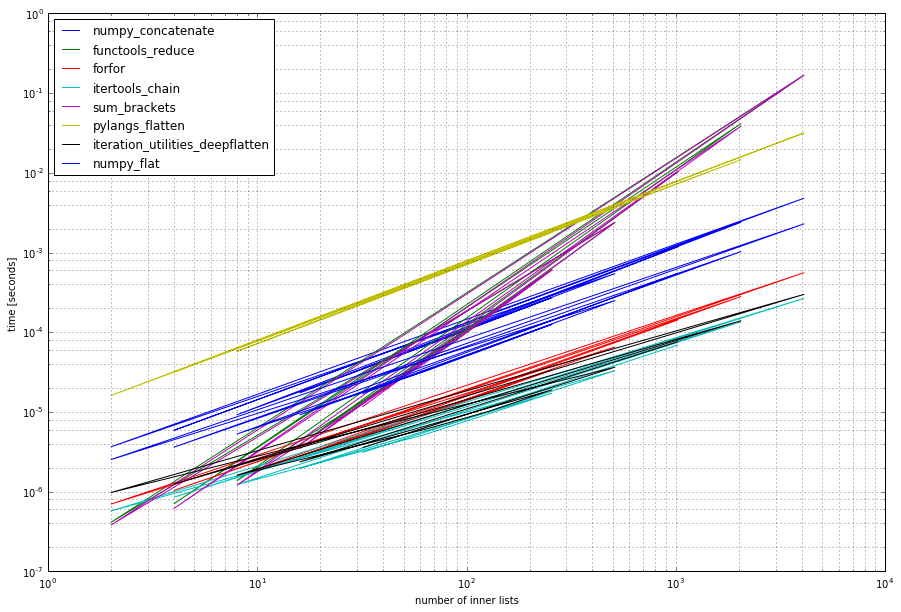使用Python脚本的过程中,偶尔需要使用list多层转一层,又总是忘记怎么写搜索关键词,所以总是找了很久,现在把各种方法记录下来,方便自己也方便大家.
方法很多,现在就简单写8种,后面再对这8种方法做基准测试.
声明:文中的方法均收集自Making a flat list out of list of lists in Python
1.定义减层方法
- import functools
- import itertools
- import numpy
- import operator
- import perfplot
- from collections import Iterable # or from collections.abc import Iterable
- from iteration_utilities import deepflatten
-
- #使用两次for循环
- def forfor(a):
- return [item for sublist in a for item in sublist]
-
- #通过sum
- def sum_brackets(a):
- return sum(a, [])
-
- #使用functools內建模块
- def functools_reduce(a):
- return functools.reduce(operator.concat, a)
-
- #使用itertools內建模块
- def itertools_chain(a):
- return list(itertools.chain.from_iterable(a))
-
- #使用numpy
- def numpy_flat(a):
- return list(numpy.array(a).flat)
-
- #使用numpy
- def numpy_concatenate(a):
- return list(numpy.concatenate(a))
-
- #自定义函数
- def flatten(items):
- """Yield items from any nested iterable; see REF."""
- for x in items:
- if isinstance(x, Iterable) and not isinstance(x, (str, bytes)):
- yield from flatten(x)
- else:
- yield x
-
- def pylangs_flatten(a):
- return list(flatten(a))
-
- #使用库iteration_utilities
- def iteration_utilities_deepflatten(a):
- return list(deepflatten(a, depth=1))
2.测试
- a=[[1,2,3],[4,5,6],[7,8,9]]
- print(a)
-
- print('--------------------------')
-
- print(forfor(a))
- print(sum_brackets(a))
- print(functools_reduce(a))
- print(itertools_chain(a))
- print(numpy_flat(a))
- print(numpy_concatenate(a))
- print(pylangs_flatten(a))
- print(iteration_utilities_deepflatten(a))
输出:
[[1, 2, 3], [4, 5, 6], [7, 8, 9]]
--------------------------
[1, 2, 3, 4, 5, 6, 7, 8, 9]
[1, 2, 3, 4, 5, 6, 7, 8, 9]
[1, 2, 3, 4, 5, 6, 7, 8, 9]
[1, 2, 3, 4, 5, 6, 7, 8, 9]
[1, 2, 3, 4, 5, 6, 7, 8, 9]
[1, 2, 3, 4, 5, 6, 7, 8, 9]
[1, 2, 3, 4, 5, 6, 7, 8, 9]
[1, 2, 3, 4, 5, 6, 7, 8, 9]
2.各种方法的基准测试(消耗时间对比)
各种方法在小数据上消耗时间差别不大,如果数据很小,没必要为了选择而烦恼,如果数据很大,可以参考下面基准测试的结果来选择减层方法.
- import matplotlib.pyplot as plt
- from simple_benchmark import benchmark
-
- #基准测试
- b = benchmark(
- [forfor, sum_brackets, functools_reduce, itertools_chain,numpy_flat, numpy_concatenate, pylangs_flatten,iteration_utilities_deepflatten],
- arguments={2**i: [[0]*5]*(2**i) for i in range(1, 13)},
- argument_name='number of inner lists'
- )
-
- #显示测试结果
- plt.subplots(1,1,figsize=(15,10))
- b.plot()
- plt.legend(loc = 'upper left')
- plt.show()

消耗时间对比
相同数据量,纵轴方向越小,方法越快.
代码可以从这里下载,需要部署Jupyter环境,可参考我的博客部署方法.




















 1865
1865











 被折叠的 条评论
为什么被折叠?
被折叠的 条评论
为什么被折叠?








